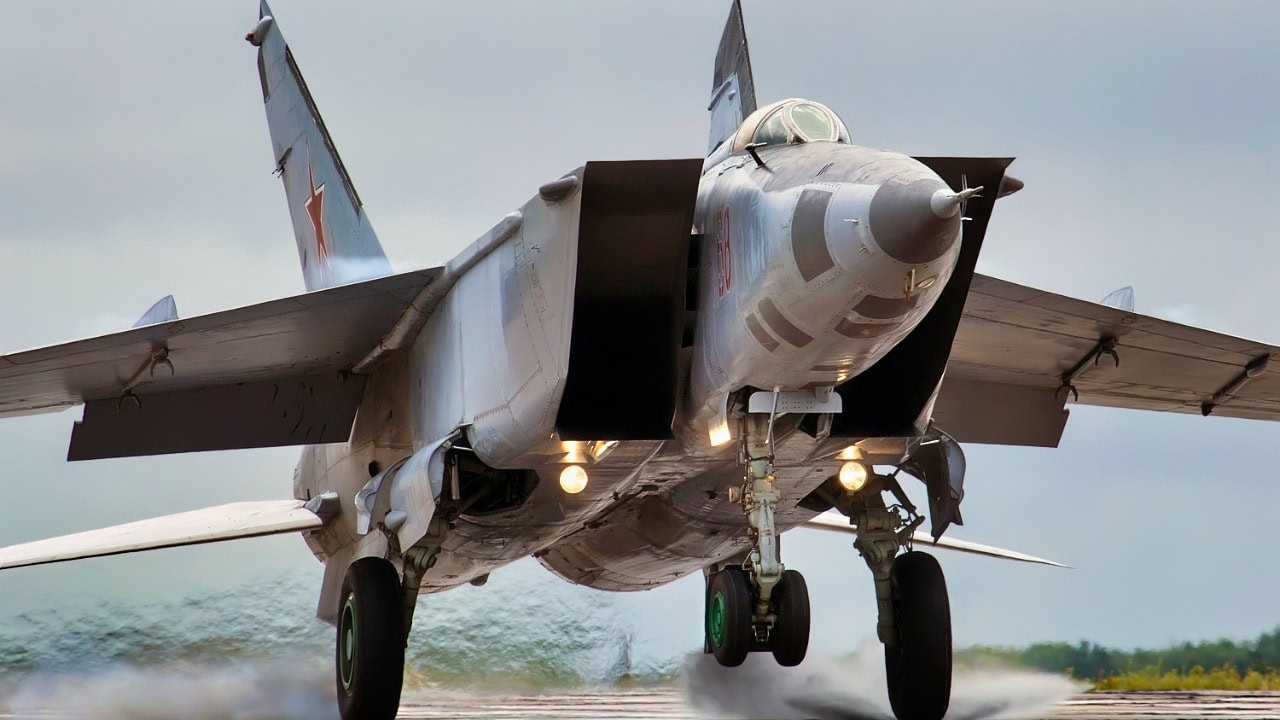The Mikoyan-Gurevich MiG-25, known by its NATO reporting name “Foxbat,” is one of the most iconic aircraft of the Cold War era.
Designed by the Soviet Union’s Mikoyan-Gurevich bureau, the MiG-25 was a supersonic interceptor and reconnaissance aircraft that pushed the boundaries of aviation technology and performance.
Today, the Foxbat is remembered by many as something of a paper tiger, which I don’t think fits. The Foxbat was designed for a particular niche that quickly became obsolete.
Built to Shoot Down the SR-71 Blackbird
The development of the MiG-25 began in the late 1950s and early 1960s, during a period of intense competition between the United States and the Soviet Union.
The primary impetus for the MiG-25’s development was the need to counter the perceived threat posed by American high-speed bombers and reconnaissance aircraft, such as the B-58 Hustler and the SR-71 Blackbird.
The first prototype of the MiG-25 flew on March 6, 1964, and the aircraft entered service in 1970. It was designed to be a high-speed, high-altitude interceptor capable of engaging enemy aircraft at extreme ranges. The MiG-25 was also intended to perform reconnaissance missions, gathering critical intelligence on enemy movements and installations.
Design and Technical Specifications
One of the most remarkable aspects of the MiG-25 is its design. The aircraft was built primarily using stainless steel, which accounted for about 80% of its structure.
This choice of material was driven by the need to withstand the high temperatures generated during sustained high-speed flight (also to cut costs).
The remaining 20% of the aircraft was made from titanium and other materials.
The MiG-25 was powered by two Tumansky R-15B-300 turbojet engines, each capable of producing 16,500 pounds of thrust, with afterburners boosting this to 22,500 pounds. These powerful engines enabled the MiG-25 to reach speeds of up to Mach 2.83 (approximately 3,000 km/h or 1,860 mph) at high altitude.
Although the aircraft could theoretically reach speeds of Mach 3.2, doing so would risk damaging the engines.
The MiG-25’s avionics included the Smerch-A2 pulse-Doppler radar, which was one of the most advanced radar systems of its time. This radar allowed the MiG-25 to detect and track enemy aircraft at long ranges, even in adverse weather conditions. The aircraft was armed with four air-to-air missiles, making it a formidable interceptor.
Performance and Capabilities
The MiG-25 was designed to operate at high altitudes, with a service ceiling of around 24,000 meters (78,740 feet). It also held the world record for the highest altitude reached by a jet aircraft, at 37,650 meters (123,523 feet).
This capability allowed the MiG-25 to intercept and engage high-flying reconnaissance aircraft and bombers.
In terms of speed, the MiG-25 was one of the fastest military aircraft ever built. Its top speed of Mach 2.83 made it second only to the SR-71 Blackbird in terms of operational speed. The aircraft’s impressive speed and altitude capabilities made it a significant threat to Western aircraft during the Cold War.
Clearing Up some Misconceptions
The MiG-25 saw extensive service with the Soviet Air Defense Forces and was also exported to several Soviet allies, including India, Algeria, and Syria. One of the most notable incidents involving the MiG-25 occurred in 1976, when Soviet pilot Viktor Belenko defected to the United States by flying his MiG-25 to Japan.
This event provided Western analysts with their first detailed look at the aircraft’s capabilities and design.
It is here that I must stand up for the MiG-25. After the Americans disassembled and analyzed the captured frame, they were disappointed by how simple the aircraft actually was. This event forever tarnished the MiG-25 and gave it it’s reputation as a paper tiger. I, however, think this is a mistake.
The Soviets never claimed that the Foxbat was anything other than a supersonic interceptor. The fighter was not a paper tiger, it is what the Soviets said it was, a supersonic interceptor designed to take down supersonic reconnaissance aircraft.
The MiG-25 and its Impacts
The Foxbat left a lasting legacy in the world of military aviation. Its development and capabilities had a profound impact on Western aircraft design and defense strategies.
The appearance of the MiG-25 may have prompted the United States to accelerate the development of the F-15 Eagle (though there is little evidence to support this theory), a highly maneuverable and capable air superiority fighter.
Despite its impressive performance, the Foxbat had its fair share of issues. Its large size and weight made it less maneuverable than other contemporary fighters, and its reliance on stainless steel construction limited its range and endurance.
However, these drawbacks were offset by its speed, altitude, and powerful radar system.
The MiG-25 remained in service with several air forces well into the 21st century, although it has largely been replaced by more modern aircraft. As the U.S. moved away from conventional reconnaissance aircraft, the Soviets, later the Russians, also moved on from the MiG-25.
Its successor, the MiG-31 Foxhound, built on the MiG-25’s design and capabilities, incorporating advanced avionics and improved performance and is perhaps one of the best interceptors currently in service.
The Foxbat was an interesting chapter in Soviet Aerospace engineering. Its development was driven by the intense pressures of the Cold War, resulting in an aircraft that pushed the boundaries of speed, altitude, and technology.
While it quickly became obsolete, the Foxbat undoubtedly had huge ripple effects on the world of military aviation.
About the Author: Isaac Seitz
Isaac Seitz, a 19FortyFive Defense Columnist, graduated from Patrick Henry College’s Strategic Intelligence and National Security program. He has also studied Russian at Middlebury Language Schools and has worked as an intelligence Analyst in the private sector.

